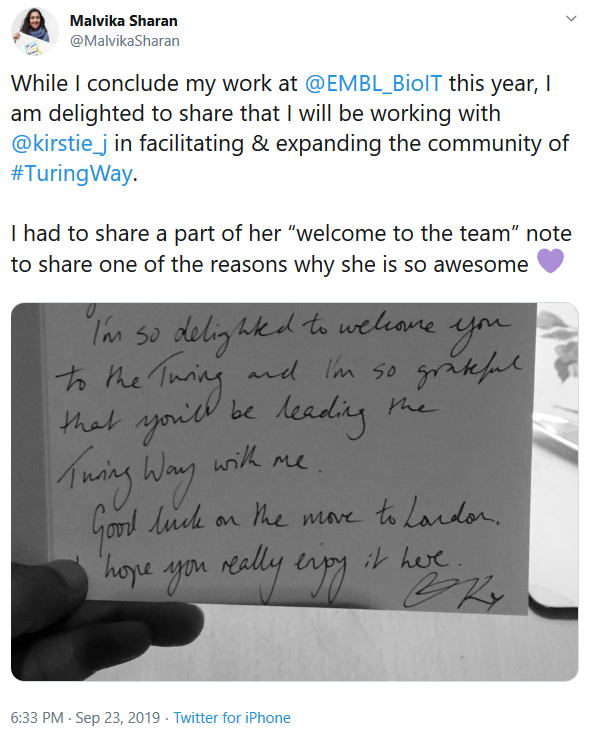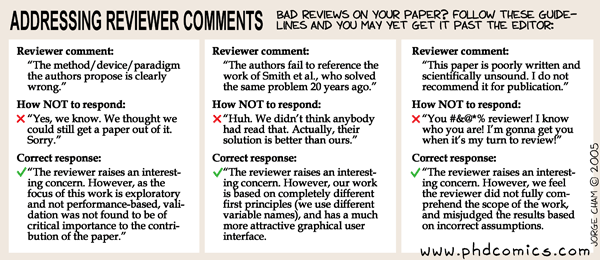Lab Meeting on 26 September 2019
We had a jam packed update this week (as usual! Do I write that every time? 🤔😆)
Scroll down past all the amazing updates to hear more about Ang and Yini’s work on a registered report to investigate the effects of polygenic risk for schizophrenia on brain structure.
Celebrations and cool things to share
Kirstie is delighted to welcome Malvika Sharan to the lab as the community manager for The Turing Way. She’s currently working one day per week as she finishes up her responsibilities at EMBL in Heidelberg and will be full time at the Turing in London mid-January.
Malvika is experiencing some imposter syndrome (aren’t we all?) and is figuring out how to juggle her current work and wanting to get started with The Turing Way, but is overall really excited to join the lab! She asked the lab members for local tips for new folks at the Turing. They suggested:
- If you want fruit arrive early - it gets delivered around 8:30am and is gone by 9am!
- The tea cupboard may look like someone’s secret stash but its actually available for everyone! Explore away!
- Meeting rooms get booked up very quickly - don’t wait as long as Kirstie does to find one (😬😉 –KW)
- Go for an explore around the library before the public are allowed in! It’s slightly creepy but really fun.
- Check-out Chalton Street next to the British Library. It has a market and lots of great food establishments. In particular, Mai Sushi!

Source: Malvika's twitter feed.
Patricia is preparing for a session on the management of computational notebooks, and specifically about preservation. Huge thank yous to Tim Head for brainstorming through this with her 😃 They might write this up as a short paper or Turing Way contribution, so stay tuned!
Yo recommends this paper “Ten simple rules for helping newcomers become contributors to open projects” (doi: 10.1371/journal.pcbi.1007296) and to join Hacktoberfest if you haven’t yet! It’s a great way to start making little contributions to open source projects, or to bring others into your project … and you get a free t-shirt if you open 4 pull requests too ✨
Isla reminded everyone (following on from the Hacktoberfest discussion) that contributing documentation can be a great way to get involved with a project. It’s a good way to familiarise yourself with the software, and the best documentation often comes from someone who has fresh eyes on the tool.
In fact, the first Reproducible Research Lunch at the Turing (starting next week) is on Hacktoberfest! Everyone is welcome and Kirstie and Louise are looking for suggestions for future discussions.
Christina is currently on holiday and recommends travelling to St. Petersburg!
Sarah ran her first “Learn Azure” session for the Living with Machines group (and is now officially exhausted 😅).
Yo also shared the link to apply for the 2020 Software Sustainability Fellowships! Fellows are also awarded £3,000 to spend over 15 months to improve how research software is done in their domains and/or area of work. She, Malvika and Patricia are fellows already and, although the money is fun, they’d recommend the fellowship for the networking and collaborations workshop alone!
Louise is helping to organise a two-day workshop at the Turing introducing Spark at the end of October.
Elizabeth shared ImageNet Roulette. (It was only available until Friday 27 September, so that link will take you to a write up of the project by authors Kate Crawford and Trevor Paglen). She was pleasantly surprised that the public outcry led ImageNet to scrub about half (!!) of their “people” category.
Ang has been exploring the Pingouin 🐧 Python package to perform standard statistical tests. Checkout the interactive demo on Binder.
Yini recommends NeuroPower which helps researchers make sure they’re appropriately powered (eg with a large enough sample size) before they start their experiments.
Questions we’re thinking about
Kirstie has joined a large collaborative project to make sure that everything they do is reproducible from the start (the project will officially launch around February 2020) so she’s thinking about ways to map members of the collaboration to ensure that everyone knows who is in the network and what information they have access to. Possibly using Network Canvas which was built for social scientists to map social networks.
Patricia is meditating on time sheets. They’re good for getting an overview of what you spend your time on (her job has a “you can do what you want - we just want to know where people spend their time so we can report” attitude) but isn’t sure how much time is worth analysing them (beyond reporting so the organisation fulfills its grant responsibilities).
The team agreed that actually managing time in an effective way is a tough problem but worth solving. (So much so that the Turing Research Engineering Group has a whole data science meta project on it!) Yo uses RescueTime to passively record what she does which is good for knowing how much overtime she’s working, but doesn’t love the feeling of being watched 👀. Louise used Harvest to realise that she wasn’t allocating her time appropriately to her different projects. For the same reason Kirstie uses Toggl sporadically. It’s been really useful in the past to realise what is being squeezed out with other tasks.
Yo is looking for co-facilitators for one of her (many) sessions at MozFest. She, Malvika and Bérénice proposed “Choosing an effective mentorship program” but unfortunately Malvika isn’t able to attend 😭 Isla volunteered - she’s facilitated a MozFest session before - so it’s going to be an even more fantastic hour at the festival 💖
Louise is looking for opinions on any of the programming, machine learning or similar meetups around London.
The lab recommended:
- PyData London
- PyLadies London
- Gender Minorities in AI
- RLadies London
- Open Data Institute events
- One Health Tech
- BBC Machine Learning fireside chats
Sarah is planning on applying for the 2020 SSI Fellowship Programme and is thinking of using the money and connections to do something Binder-related, for example run another workshop. Any advice or ideas on shaping the application would be appreciated! You can comment on the issue at the JupyterHub Team Compass GitHub issue.
Yini finds herself more effective at night than during the day and is worried that isn’t the right way to work. She was wondering how to change that, but the lab members all agreed that it’s better to work to your best strengths! No need to change to fit the standard 9 to 5 day 🌃 🌙 🦉
Ang is looking for tips on finishing his first revision to a journal. Malvika recommended acknowledging the value that the reviewer comments added, admitting if there were clear mistakes and clarifying how you’ve addressed them, and making sure that your response is kind to the real humans who reviewed the paper. She also recommended (and Kirstie strongly concurs!) getting lots of people to read the response and give you feedback before you send it in. Patricia shared the following PhD Comic 😆

Georgia has been running focus groups for the Autistica/Turing Citizen Science project and is looking for tips on facilitation. She’s also writing up her experiences with building an Open Science game at the eLife Innovation Sprint and is looking for feedback and suggestions to improve it!
A registered report to investigate the effects of polygenic risk for schizophrenia on brain structure
The main agenda item for this meeting was Ang and Yini presenting their work on developing a registered report to analyse the Adolescent Brain Cognitive Development (ABCD) dataset.
This study is following 10,000 9 and 10 year olds in the USA for 10 years 😱 The goals is to collect a census representative sample, and at the moment the cohort is a little more educated than the whole USA, but not far off! (Here’s a link to the participant demographics.) They release data every year: https://abcdstudy.org/scientists/data-sharing which makes it really exciting to participate in!
Their research question is whether there is an effect of polygenic risk for schizophrenia (Martin et al have a nice review, doi: 10.1016/j.biopsych.2018.12.015) on cortical thickness and surface area at ages 9 and 10. Rather like this analysis by Neilson et al (doi: 10.1016/j.biopsych.2019.04.013) in UK Biobank data…but in young children to see if there is evidence (in terms of brain structure) for the developmental hypothesis of schizophrenia (Owen et al, doi: 10.1192/bjp.bp.110.084384).
We talked about the challenges of setting quality control inclusion and exclusion criteria for magnetic resonance imaging data given how many different processing steps there are and Ang and Yini gave us a tour of the jupyter notebooks they’ve written containing the analysis code for the study. These aren’t yet public…but they will be on submission - maybe in the form of a Juypter Book 🚀🌟
Thank you Ang and Yini for the presentation, and to all the group for the fascinating discussion 💖
